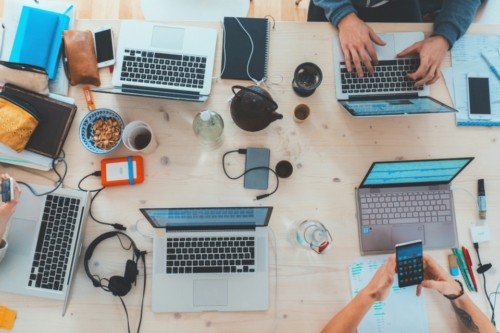
Collecting data is only one piece of the puzzle when it comes to defining your company as “data-driven.” The real trick to improve customer feedback is transforming collected data into actionable insights that will help drive your company’s success.
Once you have enough reliable data to drive useful analysis, the question becomes, “How?”. How do you make sense of the vast stores of feedback data? Before taking any action from customer satisfaction metrics, you must learn how to understand your data by taking the following steps:
Before you can work with your data, you must find a place to store it. Use a database platform and follow best practices when collecting and working with customer feedback data. This standardizes the information that you collect, makes it easier to ensure data quality and helps with smoother collaboration between departments.
Databases present several advantages over other data management software, such as spreadsheets. To list a few, databases:
- Provide more intuitive and robust cataloging capabilities
- Run more efficiently and are capable of handling much larger volumes of information
- Protect data integrity and help prevent redundancy or errors
- Allow for secure and efficient collaboration
- Are easily searchable later on
Used wisely, customer feedback measurably boosts your company in several ways and informs your overarching product decisions. Client feedback answers questions like:
- Do customers seem to “get” your product line?
- Are there fundamental issues that you need to address right away?
- Is it time to add or scrap features?
- Should you enhance or reduce your product line?
- Is there any quality of life changes that you can make to your product or service?
To glean these insights and more, be sure to sort your customer feedback data into relevant categories — for instance, positive, neutral and negative reviews. Then, visualize the results using graphs or diagrams to find patterns, trends or anomalies in your data.
By categorizing your data and visualizing feedback, you will have a comprehensive understanding of your product’s performance and discover strengths, as well as areas of potential improvement. Using eye-catching and clear visualization, you will also discover themes and be able to track changes over time to determine whether your business decisions are improving performance.
Once you have your data sorted and visualized in easy-to-understand graphics, it’s important to develop a uniform process for managing and responding to customer feedback as a team.
Gather team members to interpret results, discuss key insights and debate possible next steps. Be sure to include members from multiple departments — customer service, marketing and product design — to gain a holistic understanding of your data and develop a comprehensive response plan.
You’ve stored and sifted through your data, wringing out the last bits of insight from all the customer feedback you’ve acquired. How do you transform your new insights into action?
Customer feedback helps you recognize your product’s flaws. Address critical issues first; have your product design team fix major bugs or sort out product failures. Then assign priorities to other issues, such as quality of life improvements or social media campaigns — discuss with your team which changes are worth investments of time and resources.
Feedback is not always constructive, but it is always valuable. Client feedback always presents opportunities to strengthen your relationship with your customers. Always thank your customers for providing insights. Let customers know that you appreciate their positive feedback and listen to customers that have had negative experiences using your product or service, assuring them that you will make necessary adjustments. Maintaining a healthy and open relationship with your customers helps develop brand loyalty and is just as crucial as delivering the changes that they desire.
- Expand marketing efforts by using customers’ positive experiences with your product or service as testimonials
- Identify product or brand ambassadors that can help spread the word
- Strengthen customer relationships with personalized responses that thank them for their feedback
- Build around aspects of your product or service that work best for customers
- Motivate and encourage your team with positive client feedback
- Identify areas where you can improve your product or service
- Determine if you need to better define your niche or target demographic
- Prevent customer churn and build trust by directly reaching out to customers before they spread negative feedback to their friends and family
- Predict emerging customer needs and changing tastes
- Track improvements over time; you can also use negative feedback in future marketing campaigns to show that you listened to concerns and improved accordingly
Feedback is a two-way street. Always “close the loop” when you receive feedback to make sure customers know you’ve heard them. Be sure to thank customers for taking the time to provide feedback and add value to your responses by communicating specific changes you will make based on their concerns.
Seize the opportunity to respond to negative reviews and other less-than-stellar customer feedback. Even dissatisfied customers will evolve into loyal patrons when you take care to respond thoughtfully and professionally to their complaints.
Keep track of how you respond to feedback. Encourage honest reviews and bolster brand loyalty by adding a line in the press about how you use each piece of customer feedback as a part of your development process.
Too often, companies can’t capitalize on potentially valuable insights because their consumer satisfaction survey data is too unorganized. It becomes an impossible task to effectively use data that is scattered among messy spreadsheets, lying useless in email accounts or simply filed away and forgotten.
Client feedback is only useful when it is organized, accurate and clear.
Information gleaned from metrics like sales data provides insight into customer behavior, but too often the data gathering stops there. Smart companies dive deeper, transforming this information into insights that can drive meaningful growth and long-term client relationships.
Take the time to craft meaningful surveys that garner helpful, reliable data — and consider offering incentives to increase customer participation.
The most effective surveys use:
- Clear, focused and thoughtful questions that aim at the real customer experience
- Shorter questions — split multipart inquiries into separate questions
- Mobile-friendly formats
- A mix of closed- and open-ended questions
You will also learn a great deal from social media platforms and product reviews. Search Facebook, Instagram and Twitter for feedback in posts, tags and photos, then log it as you would survey input. Also use third parties like Amazon to uncover information about customer motivation and functional product issues. Once in a while, you might even uncover unforeseen insights from customers that use your products in unexpected ways.
While typical analysis performed by data scientists can prove useful, many companies today are turning inward for this kind of work. One factor is efficiency; data analysis often proves cumbersome and costly, even cost-prohibitive, for newer companies. Another is authenticity; outsider analysis will always be inherently distinct from a company’s true culture, goals and product development styles. No one knows your company like you do.
The good news is that automated tools like Pipefy help streamline the process and put the power of data analysis directly in your hands.
It’s all about centralization. With customer-focused automation, you can say goodbye to sorting through emails, confusing spreadsheets and clunky legacy systems that can’t integrate with your other tools.
The Pipefy platform integrates unique opportunities for customer feedback data and analysis whenever there is customer interaction. We do this through proprietary tools and features that promote the use of clear processing rules and standardization.
Empower every member of your team to make data-driven decisions based on real-time information.
- Public forms let you interact with customers through a shareable URL. Customization allows you to focus on and organize the exact customer feedback data you need, and then provide your response.
- Database checklists help you organize customer feedback data in a centralized, secure environment.
- Centralization eliminates duplicate entries, cuts down repetitive entry tasks and increases your data’s security.
- Database capabilities help you quickly access and organize enormous data loads about consumer behavior, product performance and so forth.
- Field conditionals enable you to create and customize interactive forms that help automate processes and increase readability and convenience.
- Email templates are ideal for updating customers. You can automate emails, such as confirmation messages, and design custom templates.
- Email messaging lets you send and receive emails within the Pipefy platform, making it easier to interact with customers, vendors and anyone outside your pipe. The platform logs and manages emails so you can easily find and come back to them later.
No matter how you go about data gathering and analysis, be sure to incorporate two key factors: centralization and organization.
Tools like spreadsheets can no longer meet the demands of today’s data-driven consumer product market. However, advances in database technology and automation have ushered in a new era of tools, such as Pipefy, that will transform your entire data collection and analysis process.
Pipefy will help make your data gathering and analysis process more efficient. We help you streamline and simplify daily operations that slow down your business workflow. Our easy-to-learn work management platform will change the way you manage how your business gathers, stores, analyzes, shares and, most importantly, uses your customer feedback. Take control of your daily work and try Pipefy for free today.










